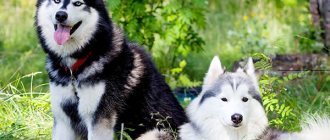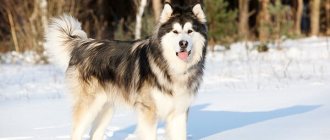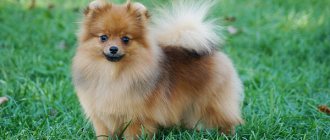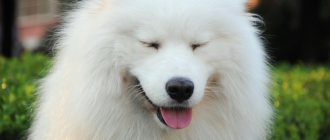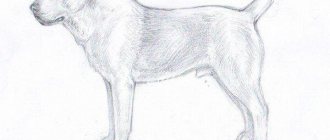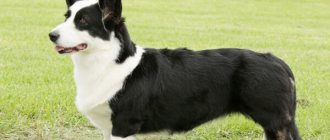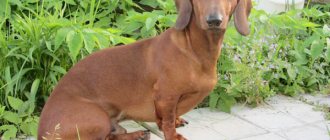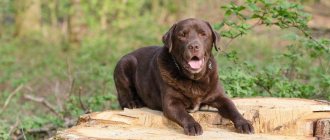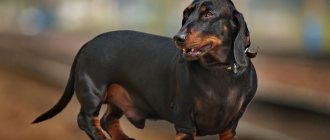Malamutes are one of the oldest dogs, distinguished by a high degree of endurance and excellent working qualities.
Possessing quite large sizes, representatives of this breed are not at all aggressive and, no matter how much effort the owner puts into it, they are absolutely not suitable for the role of guards.
In this article we will look at what types of Malamutes exist in the world and what each of them looks like.
Breed standard
Malamutes are powerful, strongly built dogs with a compact, square body and strong paws with well-developed muscles. All this makes them ideal sled, working and hunting dogs.
NOTE!
This is one of two breeds in the world whose representatives do not bark, but make sounds reminiscent of a grunt.
breed standard
:
- the head is wide, but proportional to the body;
- the muzzle is voluminous, not pointed;
- the ears are erect, V-shaped, set wide, with rounded tips;
- scissor bite;
- the eyes are small, almond-shaped, the iris is brown;
- The nose is pigmented black or brown.
Excessive body weight, thinness, incorrect positioning of the limbs or their discrepancy with the accepted and approved form of the standard, as well as disproportionality of the body are serious disadvantages of the breed.
Dogs with blue eyes and any manifestation of aggressive behavior are also considered a deviation from the breed standard.
Health
Alaskan Malamutes are strong and hardy animals. Average life expectancy is 12 years. Sometimes there are long-livers who reach the age of 17. With proper care and healthy parents, problems rarely arise.
Diseases
Some dogs suffer from:
- hemeralopia (night blindness);
- progressive retinal atrophy;
- hypothyroidism.
The greater weight of an adult Malamute also causes inconvenience. Because of it, joint diseases appear. Excess body weight only makes the situation worse.
Vaccinations
An Alaskan Malamute puppy needs the same vaccinations as other breeds. Vaccination is carried out at the age of:
- 7-8 weeks;
- 10-12 weeks;
- 6 months.
In the future, animals are revaccinated annually. The veterinarian can adjust the vaccination schedule based on the Alaskan Malamute's immunity and the presence of common diseases in a particular area.
Character and temperament
Malamutes have a friendly disposition and sometimes even behave overly friendly with people. These are quite large dogs, but they cannot be used as guards, since they are not characterized by aggression and are very friendly towards everyone, even strangers.
They are pack animals that need constant contact with other dogs or people. They cannot live alone; such conditions negatively affect their mental and physical health.
Malamutes, despite their devotion and loyalty, cannot be called dogs of one owner - as soon as a person shows weakness and ceases to be a leader and leader for the pet, representatives of this breed will switch to another, one in whom they see these qualities.
These dogs are smart and quickly remember commands, but their natural stubbornness and desire to dominate takes over and they may refuse to follow commands, which complicates the process of training and education. When raising a Malamute, it will not be superfluous to undergo the OKD.
Malamutes need regular active walks and physical activity to help maintain health and get rid of accumulated energy.
Character
Alaskan Malamutes are kind and peaceful. Previously, they guarded Eskimo settlements, but now they have lost their protective qualities. They are non-aggressive and are not “one-owner” dogs.
The Malamute breed exhibits unmotivated anger due to:
- psychological trauma;
- abuse;
- lack of education.
These are pack dogs that require constant attention from the owner. They cannot be kept in a closed enclosure or on a chain. If the owner is unable to devote enough time to the pet, he will look for his “portion of love” from other people. But such behavior cannot be called betrayal. These are innate characteristics that you should familiarize yourself with before purchasing a Malamute puppy.
The dog's character is reminiscent of a good-natured, mischievous, but sometimes naughty child. However, an adult dog never loses self-esteem. Proud posture and head held high are his integral attributes.
Almost all Alaskan Malamutes cannot bark. But they howl and grumble expressively.
Main breeding lines
Malamutes are divided into 2 main types - M'Lut and Kotzebue. Representatives of these breeding lines have some differences in appearance, which relate mainly to the color of the coat and the size of the adult individual.
Kotzebue
These are friendly, strongly built dogs with a dense and long coat of gray (wolf) color. They are characterized by the presence of a kind of mask on the face and head.
This breed began to be bred in the USA (in New England), by crossing Labrador Huskies, Greenland and Eskimo dogs and, of course, Alaskan Malamutes. As a result of such selection work, unique dogs were bred, which, unfortunately, remained in the shadows for quite a long time and were considered only one of the varieties of the so-called “Eskimo dogs.”
These dogs were recognized as a separate breed only in 1935 by the American Kennel Club (AKC).
M'Loot
Malamutes of this line have larger dimensions (the average height of an adult dog at the withers is 63 cm, weight is 38 kg), they are characterized by aggression, and the coat of these dogs can be blue, white, white-black, white-brown, sable or white. - red color.
Almost simultaneously with the selection of Kotzebue, a dog breeder from New Hampshire began developing a new breed, crossing dogs from Minnesota, Montana, Alaska and 2 female white Canadian Eskimo dogs. Due to the variety of breeds that were selected for breeding work, the Malamutes of the M'Lut line turned out to be very diverse and their coat has many color variations.
Representatives of this line were not registered at the 1st free registration, since the person who bred the breed was not interested in its registration and participation in exhibitions.
Features of maintenance and care
The homeland of Malamutes is Alaska. They have long lived in the harsh arctic climate, easily winter outside and are not afraid of bitter frosts.
A private house with a spacious plot is best suited for maintenance. Here the dog will be able to throw out the energy seething in him without harming the owner and others.
The Alaskan Malamute in the apartment feels depressed and begins to play pranks - gnawing things, scratching floors and furniture, howling.
The animal has an innate passion for digging holes. It is impossible to wean a dog from this. Therefore, care should be taken to ensure that she does not dig under the fence and escape.
Combing
Animal fur requires attention. How to care:
- Combing is a mandatory procedure. During molting, which occurs twice a year, it is carried out every day. An Alaskan Malamute in an apartment sheds almost all of its undercoat. If the fur is not removed, the body will become covered with tangles;
- During other periods, it is enough to comb the coat once a week and use a slicker once a month to keep the undercoat in order.
The rest of the care is standard:
- rubbing the eyes – once every 7 days;
- ear cleaning – once a month;
- Trimming nails as they grow.
The fur between the pads is clipped or shaved to prevent slipping on hard surfaces.
Bathing
It is enough to bathe Alaskan Malamutes once every 2-3 months. To prevent coarse fur from becoming brittle after washing, it is simultaneously dried and combed.
Animals love to swim in rivers and lakes. This is how they protect themselves from heatstroke in hot weather.
Walk
To channel the Alaskan Malamute’s energy “in a peaceful direction,” it needs to be taken out for runs regularly. Without constant load it will become uncontrollable.
It is better to walk the Alaskan Malamute on a special area equipped with slides, obstacles and other structures. Here he can frolic to his heart's content.
Feeding
The pet is given either ready-made food or home-cooked food. Mixing both diets is not recommended. The gastrointestinal tract adapts to monotonous food, and sudden changes in dishes cause digestive upset.
Photos and descriptions of varieties
Malamutes are a breed of Arctic dog designed for heavy work and sledding. They adapt well to the harsh northern conditions, so breeding work, as a rule, was carried out in regions where there was a need for hardy and strong animals.
There are quite a few regional varieties of the breed, which have certain features of appearance and character.
Siberian
The Siberian Malamute is similar in appearance to the Alaskan. Their difference is expressed in a look in which a certain slyness is read, a more noble carriage of the head and a soft coat.
These dogs have a completely different character and disposition. Representatives of the Siberian variety are weaker dogs; they do not have such a high degree of endurance as the “original” Malamutes. In addition, they are more flexible and not so stubborn, which greatly facilitates the process of raising and training them.
Despite the easy-going nature of the Siberians, these dogs are quite self-sufficient, decisive and can sometimes show absolute indifference to what is happening around them.
Siberian Malamutes grow up to be loyal friends, become real nannies for children and excellent companions for those who prove their leadership to them.
Tibetan
The Tibetan Malamute is one of the most expensive and largest representatives of this breed. On average, the height at the withers of adult dogs reaches 65 cm, and weight – 50 kg. In addition, this variety has the thickest coat.
IMPORTANT!
Since Malamutes of the Tibetan breeding line have fundamental features, they do not correspond to the official show standard.
Altaic
The Altai Malamute is a dog with high paws, a slender body and well-developed muscles. At the same time, it does not look bulky - within the breed, these are quite compact dogs.
Representatives of this species are more suitable for hunting than for riding. Exterior features include a different tail set and eye shape.
American
The American Malamute is not inclined to start fights, however, another name is firmly attached to it - “gray wolf”.
These dogs have a large back, a long loin, straight muscular limbs, and a thick coat of various colors. American Malamutes are intelligent and easy to train and train.
Alpine
The Alpine Malamute is a very friendly and good-natured dog, but you should not expect it to be easy to communicate with.
You can achieve respect and obedience from these dogs only by proving to them your unconditional leadership and becoming their authority and leader. Alpine Malamutes are difficult to train because they are too stubborn and may refuse to follow established rules and follow commands.
Representatives of this breed are not suitable for the role of guards - they are too friendly towards everyone without exception and would prefer to make friends with a stranger rather than attack him, protecting the owner’s property.
Canadian
Canadian Malamutes or "Wolfhunds" were created by crossing Canadian Black Wolves and Alaskan Malamutes.
Dogs of the Canadian Malamute breed can only be owned by experienced dog breeders who have a clear understanding of the behavior of wolves.
These dogs cannot stand loneliness and can be aggressive towards children and sick people.
Japanese
To obtain the Japanese Malamute breed, breeders carried out work on crossing Malamutes and Spitz dogs, as a result of which a completely new breed was developed, called the Akita Inu.
This Asian Malamute has pronounced hunting skills, a three-layer coat of varying lengths, which can be white, brindle and white or red and white.
Chinese
Chinese Malamutes, like Tibetan ones, are large in size. To get these dogs, breeders mated Malamutes and Mastiffs.
Alaskan
The Alaskan Malamute (or Laika) is a dog with a strong and muscular build. The breed is divided into 2 intrabreed species - M'Loot and Kotzebue.
An adult male Alaskan Malamute grows up to 63.5 cm at the withers and weighs 38 kg, and a female reaches a height of 58.5 cm and weighs 35 kg.
Yakut
Dogs of the Yakut Malamute breed were bred exclusively for work; today they quite often participate in weight-pulling competitions, since they can move an object weighing up to 400 kg.
These are peaceful and friendly dogs, so they cannot be used as guards. It is not easy to train them due to their inherent stubbornness and independence, and their developed hunting instinct requires early socialization, without which normal contact between Yakut Malamutes and other animals is impossible.
Valdai
These are medium-sized dogs with a neat, elongated muzzle.
The uniqueness of the Valdai Malamutes is that their coat can only be wolf color. The ears of these dogs are not drooping, they are set high, and their limbs are completely covered with hair.
NOTE!
Representatives of this breed often exhibit heterochromia.
Caucasian
The weight of Caucasian Malamutes can reach 50 kg. These dogs have developed hunting and guard instincts and very thick hair. They tolerate frost well.
Armenian
Representatives of this line are well suited for living in the yard, provided they have an equipped open-air enclosure. If you provide them with regular long walks, they can be kept in a city apartment.
Armenian Malamutes require minimal care and are absolutely not picky about feeding.
English
These dogs are called Samoyeds.
These are smart, strongly built, hardy animals with thick hair, divided into 2 types - wolf and bear.
Description of the breed, characteristics
Individuals of this breed have a wide back and body, a strong loin that is larger than average. The limbs are straight, correctly positioned, their muscles are superbly developed, so Malamutes can easily run long distances when carrying loads. These dogs have very thick fur, as this breed lived for centuries in a cold climate, in which they often had to sleep in sub-zero temperatures on the snow. Wool shades may vary.
There are two subspecies of Malamutes:
- Kotzebue;
- mꞌmut.
Representatives of the first direction are all the first individuals who have been registered with the American Kennel Club. The height at the withers of these dogs is less than that of the subtypes of subsequent standards. Kotzebue Malamutes have a strong, medium-sized head with small ears, a voluminous and deep chest, and strong paws. The movements of such dogs are smooth. Since these dogs were not hunting dogs for centuries, but only sled dogs, their character is even and calm, completely devoid of aggression. Dogs are very smart and easy to train.
The second subtype of Malamute appeared in the middle of the last century, when this breed was re-registered. These individuals are tall, have a more elongated muzzle, a wider skull shape, and ears set high. The chest is much smaller than Kotzebue's, weaker, so they do not move as smoothly. One of the disadvantages of this subtype is aggressiveness, so it is more difficult to train them, and the owner must immediately let his pet know who is in charge in the house.
The height of males at the withers is about 63 cm, and the weight is 38 kg. For girls, these parameters are 58 and 34 cm, respectively.
It is worth talking separately about the character traits of representatives of this breed. These individuals are extremely energetic and independent, and have a friendly character. Malamutes are trusting even of complete strangers, so they will not make good guards. Since they love an active lifestyle, as well as freedom.
But they are often aggressive with their relatives and other pets, so if there are other dogs or animals in the house, then it is better not to buy a Malamute as well.
Representatives of this breed are extremely freedom-loving and stubborn. And the puppies of these dogs are much more mobile and active than adult dogs.
Types of colors
The options for Malamute coat colors are amazing in their diversity. Basically, this is a combination of white and other shades, making each individual individual.
The monochromatic coat color of representatives of this breed can only be white .
Black and white
The awn is black, the undercoat is black or dark gray. The Seal and White color can also be included in this category - in such dogs the guard hairs are completely black or only at the tips, and the undercoat is white or cream-colored.
Puppies of these colors have almost the same color at birth; it is almost impossible to predict what the adult will be like.
Gray with white
The guard hairs are gray, and the undercoat is white, cream or light gray. Any inclusions of a reddish tint are unacceptable.
Although there may be darker or black hairs along the topline, Malamutes with this coloration give the impression of a gray dog.
Sable with white
The awn is black or gray, the undercoat has a reddish tint. Visually, shades of both black and red are clearly visible.
Silver with white
In such dogs, the guard hair is pigmented with a light gray color, and the undercoat is white.
Gray-white, silver-white and sable-white colors can be classified as one color group, which most people mistakenly consider to be the only correct one for this breed.
Red with white
The awn is colored in any shade of red: from rich brown to golden yellow. Black color is not acceptable.
Blue and white
Blue color is formed as a result of genetic dilution of black. Blue and white Malamutes have blue rings on the guard hairs, and the undercoat is dark gray or blue.
Solid white
These Malamutes have a snow-white coat and the same undercoat. Some individuals have a less pronounced creamy mask. They can only be born as a result of the mating of two white individuals.
Maintenance, care
Since these dogs have very thick and fairly long hair, many novice dog breeders are interested in how to care for it. For those owners who have the opportunity to keep this breed in the yard, there is no reason to worry - such animals are able to independently maintain its cleanliness.
These pets shed twice a year, during which time they should be thoroughly brushed every day. in hot weather it is better to keep them in the shade so that the animal does not get heatstroke. These dogs should be washed as needed, as they are very clean.
This dog leads an active and energetic lifestyle, so it will be too difficult for him in an apartment. In a private home, it is better to separate a large enclosure for these pets and install a kennel. But you need to keep an eye on your pet - he loves to dig holes, and also chase cats and other small animals that wander into his territory.
It is good to take such pets with you on long trips as a porter - they can carry a cart with luggage up to 350-380 kg. But you should not load your pet until its skeleton and muscles are fully formed - usually this happens by the age of one year. Moreover, you can start training your pet earlier - just take him for a run in the morning and evening, and the owner can ride a bicycle and the dog can run alongside.
It is better not to get a Malamute if there are children of preschool and primary school age in the house - although these dogs are friendly, they are not very patient, so playing together with small children may not always end well.
Feeding
Most often, owners buy special dog food to feed individuals of this breed. But to prevent such food from harming your pet, you need to pay attention to what is written on the package:
- such food should only be premium class;
- the inscription organic means that only natural meat was used to produce the food, and not artificial additives;
- holistic – this food is intended for those pets who have problems with the gastrointestinal tract;
- hymam-grade – those products from which “dog” food is prepared can be consumed by the owner himself.
You should not encourage your pet if it begs for a piece of food from the owner's table. The dog can earn encouragement if only it follows the command correctly.
Upbringing
Representatives of this breed have a number of not very good character traits:
- they prefer to dominate;
- very stubborn and freedom-loving;
- great strength.
Therefore, when training these dogs, a lot of endurance, patience and perseverance will be required. You should start raising a puppy from the first days of his appearance in the house. It should be accustomed to its place; during the training process, the pet must learn to behave correctly in the house, and after all the necessary vaccinations, on the street. Training should also begin as early as possible, and the first lessons should be given by an instructor who will not only show how to train the puppy, but also determine the degree of load that will need to be adhered to.
When training, you cannot raise your voice or engage in physical assault - any commands are carried out only in an even tone. These dogs are stubborn and freedom-loving, and this should be taken into account when training your pet.
Parenting mistakes
The main mistakes when raising a Malamute include:
- untimely start of raising and training a dog;
- if the owner does not have the patience to train a disobedient pet, and he begins to raise his voice, give commands in a harsh tone, or may hit the puppy - all this is unacceptable when raising a Malamute;
- You cannot train occasionally - you should train your puppy every day. Therefore, if the owner is too busy, then you need to think carefully before purchasing a puppy of this breed.
Mini Malamutes – do they exist and what do they look like?
The dwarf malamute or “Alaskan Klee Kai” is an independent breed, the representatives of which, due to the mask on the face, look like a husky, but have a completely different character.
These dogs were bred from the mating of Alaskan Malamutes, Laikas and American Eskimo dogs.
Representatives of this breed, due to their calm nature and small size, do not require complex specific care or professional training skills. They tolerate frost well and are suitable for both outdoor and indoor use.
Alaskan Klee Kais grow up to be good friends and faithful companions of their owner, in addition, they become excellent nannies for children.
Smooth-haired and long-haired
Among the representatives of the Malamute breed there are individuals with short and long coats, but not all of them correspond to the breed standard.
Smooth-haired
In accordance with the official breed standard, the coat of Malamutes consists of 2 layers - a dense fluffy undercoat, the length of which reaches approximately 2.5-5 cm, and thick and hard guard hairs no more than 7.5-10 cm long. The guard hairs around the neck are raised and form dense pubescence.
The coat and undercoat are shorter on the sides and longer on the neck, shoulders, rump, pants, loins and along the ridge.
In summer, the coat may be less long and dense.
Representatives of this breed cannot be cut; they are only allowed to tame the fur on their paws a little to give them a neater and more clearly defined appearance.
Longhair
In long-haired Malamutes, the length of the guard hair exceeds 10 cm. This fluffy representative of the breed looks impressive, but does not meet the standard.
The biggest malamute
There is a 3rd type of Malamute - the so-called giant, almost the size of an Alabai, bred on the basis of the M'Lut type. Such Malamutes have the largest height at the withers - up to 70-80 cm, and weigh up to 85 kg.
The opinion that they are the closest match to the original Malamutes is erroneous. Such representatives of the breed are nothing more than marketing and an attempt by unscrupulous breeders to increase the popularity of individuals that do not meet the breed standard.
IMPORTANT!
Such a huge Malamute has many health problems and has a significantly shorter lifespan.
How to choose a puppy?
To avoid buying a mixed breed or a puppy with any diseases, you should purchase your future pet in a specialized nursery from professional breeders who value their reputation and the quality of the breed.
When choosing a Malamute puppy, you need to make sure that it has:
- shiny coat without bald patches and dandruff;
- skin without rashes and irritations;
- pink mucous membranes;
- scissor bite;
- clean ears without unpleasant odor or discharge;
- there is no increased lacrimation.
A small Malamute should be developed in accordance with its age, be active, playful, curious and friendly. He should not show signs of exhaustion or, on the contrary, excess weight.
NOTE!
Most pathologies characteristic of this breed are hereditary, so it is important to find out about the health of the puppy’s parents.
